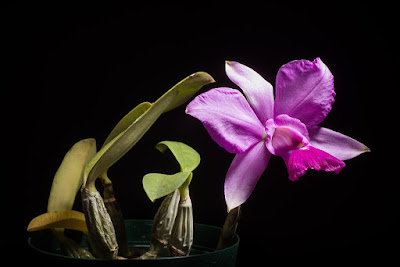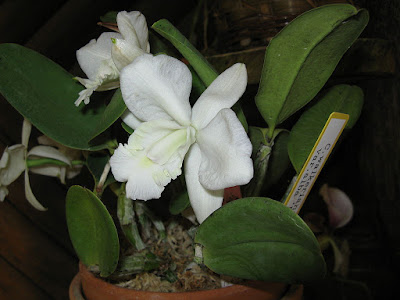Cattleya walkeriana orchid is native to the Brazil (includes the states of Minas Gerais, Goia, Bahia and Mato Grosso to São Paulo). It is an epiphytic orchid on large trees with rough bark but also lithophyte on limestone plateaus, mossy rocks, river banks or cliffs, where it behaves in xerophyte (in full sun, exposed to high light intensities). and at very high temperatures). It grows from the seashore up to 2,000 meters above sea level, making it easily adaptable to growing.
Cattleya walkeriana orchid, also called as Walker's Cattleya, is a species of the genus Cattleya. Several synonyms are know for this species such as: "Cattleya bulbosa Lindley 1847"; "Cattleya gardneriana Rchb.f 1870"; "Cattleya princeps B.-Rod. 1877"; "Cattleya walkeriana subsp. princeps (Barb.Rodr.) L.C.Menezes 2011"; "Cattleya walkeriana var. bulbosa (Lindl.) Fowlie 1977"; "Cattleya walkeriana var. princeps L.C.Menezes 1993"; "Epidendrum walkerianum [Gardn.]Rchb.f 1862". This species was discovered by George Gardner in 1839 or 1840 in Brazil at the state of Bahia. He published the description in 1843 in the London Journal of Botany. He dedicated this orchid to his traveling companion, Edward Walker , who accompanied him on his journey to Brazil. The first successful flowering in cultivation dates from 1947. This species is very close to Cattleya nobilor , with which it can be confused.
IDENTIFY CATTLEYA WALKERIANA ORCHID
Cattleya walkeriana orchid is native to the Brazil (includes the states of Minas Gerais, Goia, Bahia and Mato Grosso to São Paulo). It is an epiphytic orchid on large trees with rough bark but also lithophyte on limestone plateaus, mossy rocks, river banks or cliffs, where it behaves in xerophyte (in full sun, exposed to high light intensities). and at very high temperatures). It grows from the seashore up to 2,000 meters above sea level, making it easily adaptable to growing.
It is a unifoliate species which, often, carries only one sheet and more rarely of two of pink-lavender color. Several varieties exist: alba , semi-alba , coerulea. Pseudobulbs are bulge shaped ellipsoidal and small (10-15 cm). They are surmounted by one or two oval leaves, very stiff, fleshy and leathery which measure 5 to 10 cm long and 3 to 4 cm wide. The inflorescence is short (3-5 cm). It usually appears at the base of the pseudobulb (rare phenomenon for the genus) but can exceptionally emerge from the apex of the pseudobulb.
The flowers, from one to three for each sheath and/or basal stem, can reach even 10 cm in width. The flower size for this orchid is up to 4 1/2 inches (12 cm). The flowers are flat, way and heavily textured and they emit a fragrance. Rose purple flower coloration. The lip colour is the same as the petal colour or a bit darker. The labellum is trilobed with a median lobe marked with darker veins and two erect lateral lobes that do not surround the column (unlike Cattleya nobilor ). Flowering usually occurs in April and lasts about a month. The flowers are deliciously scented. There are several additional color forms available vary the shape and color of the flowers: dawn (sepals, petals and labellum totally white), semi-dawn (sepals and white petals and labellum all colorful or only bordered with lilac), cerulea (bluish flowers of variable intensity), concolor (all the flower of the same color).
GROW AND CARE CATTLEYA WALKERIANA ORCHID
The cultivation of Cattleya walkeriana orchid does not present great difficulties because of its adaptation to different habitats. In winter, it can withstand harsh conditions (without falling below 12°C), but in summer it will withstand very high temperatures.
It requires, however, a high brightness to be able to bloom and the top of the greenhouse suits him well, but suffers from excesses of light and prolonged periods of shade (pseudobulbs tend to lengthen and affect the flowering).
Cattleya walkeriana is usually mounted on cork slabs or similar. Can also be grown in a medium that drains very fast, such as coarse bark nuggets: it must be taken into account that the Walkerian Cattleya does not tolerate excessive humidity and it is therefore advisable to place it in a high position of the greenhouse.
Watering will be abundant during growth and greatly reduced in winter, when the pseudobulbs reach maturity. After watering, the compost must dry quickly. It will therefore be necessary to have a very well drained substrate. Under no circumstances should this orchid be watered until the roots have completely dried.
This plant does not require a particular period of rest: it is sufficient a slowing down of winter fertilizations and wetting or in any case post-flowering.
The main enemy of this Cattleya is the cotonose cochineal, which must be kept under control with immediate action, for example by passing the suspect plant with a toothbrush soaked in water and soap. I recommend treatments with specific insecticides, better if systemic.















I need to correct you, Cattleya walkeriana is a unifoliate orchid, occasionally putting forth two leaves, but rare. Cattleya nobilior is similar
ReplyDelete, except for a different fragrance and bifoliate foliage.
Thanks for the information! Sorry for late reply!
Delete